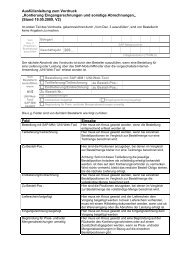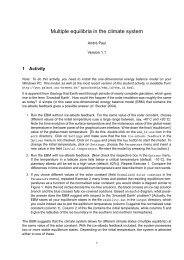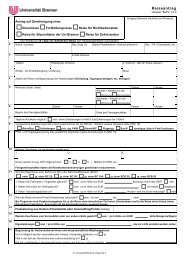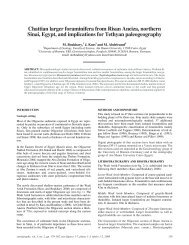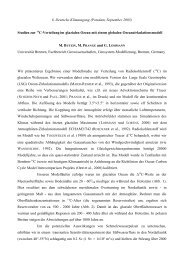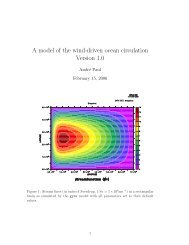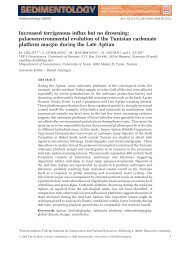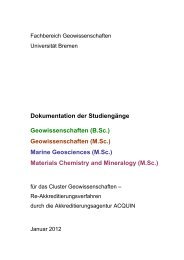Forschung im HLRN-Verbund 2011
Forschung im HLRN-Verbund 2011
Forschung im HLRN-Verbund 2011
- Keine Tags gefunden...
Sie wollen auch ein ePaper? Erhöhen Sie die Reichweite Ihrer Titel.
YUMPU macht aus Druck-PDFs automatisch weboptimierte ePaper, die Google liebt.
102Does a sponge reduce jet screech?Opt<strong>im</strong>al control to reduce supersonic jet-noise with porous mediaJ. Schulze, J. Sesterhenn, Institute of Fluid Mechanicsand Engineering Acoustics, Berlin Universityof TechnologyAbstract• Supersonic jets used in aeronautics will be <strong>im</strong>perfectlyexpanded in flight. The adaption to theambient pressure takes place in a sequence ofoblique shocks• The shock/shear–layer interaction may triggerthe shear layer at the nozzle exit, forming a feedbackloop which results in an extremely loudnoise component called screech (160 dB).• The min<strong>im</strong>ization of supersonic jet noise (especiallyscreech) is a matter of particular concernand the focus of the present project.• The idea is to place an opt<strong>im</strong>ized porous mediumaround the nozzle to suppress the feedback loopand thus to min<strong>im</strong>ize jet screech.• Multid<strong>im</strong>ensional high order and three–d<strong>im</strong>ensional CFD opt<strong>im</strong>ization application solvedon a half billion points with at least 1024 cores.Supersonic jets, as found in civil– or military aircraft,are responsible for loud noise sources, pollutingthe environment [1]. One can distinguishbetween three physical flow phenomena responsiblefor supersonic jet noise. The first and usuallyquietest noise sources are of rather low frequency,and are caused by the turbulent mixing in the shearlayers surrounding the jet core. Especially vortexpairing contributes to these sources. A secondphenomenon, the so called shock induced noise,is caused by an interaction of these turbulent eddieswith the oblique shocks in the jet core. Shockinduced noise is of higher frequency than mixingnoise and distributed over a vast range of frequenciesin the power spectrum. In contrast to mixingnoise which is mainly directed in downstream direction,shock induced noise is directed mainly inthe upstream direction.Considering a subsonic Co-flow of the supersonicjet, the upstream traveling shock inducedacoustic waves can reach the nozzle exit. At thispoint, these acoustic pressure fluctuations are triggeringthe Kelvin–Helmholtz instabilities in the mixinglayers. On their way downstream the jet, the instabilitiesare growing to lager coherent structuresand interacting with the oblique shocks in the jetcore. Again, shock induced noise is emanated upstreamand closing a feedback loop with a certainfrequency. In the literature this effect is referred toas screech and can produce sound pressure levelsof up to 160 dB.As mentioned above, the screech feedback loopis closed by upstream traveling acoustics interactingwith the nozzle exit lip. These acoustics are <strong>im</strong>pingingat the nozzle lip, being reflected, and causinga pressure gradient at the nozzle exit, forcingthe instabilities in the thin mixing layer. Thus, by amodification of the nozzle lip, the screech tone canbe influenced. Generally speaking, a thick nozzlelip is producing louder screech tones than a smalllip.The focus of the present research project lies inthe min<strong>im</strong>ization of jet screech by a modification ofthe nozzle exit. In contrast of changing the nozzlegeometry, we will follow a different approach byadding a porous medium at the nozzle exit to suppressscreech tones. The idea is to damp <strong>im</strong>pingingacoustic waves in the porous medium at thenozzle exit to suppress their sensitivity to forced instabilitiesin the mixing layers.Porous media can be a complex threed<strong>im</strong>ensionalgeometry with pores of a vast range ofdifferent length scales. A usual fashion in CFD isto create a mesh around the geometry of interestand solve the flow in the resulting computationaldomain. Using a high order finite difference codewith structured grids, as it is necessary for highlyaccurate aeroacoustic applications makes this approach<strong>im</strong>practical.To this end, the porous medium investigated, ismodeled by a volume force, s<strong>im</strong>ilar to Darcy’s lawfor incompressible flow. For the present aeroacousticapplication the volume force is added to thefull compressible Navier–Stokes equations leadingto a new set of porous flow equations.A porous medium is characterized by only twoparameters, the porosity φ and the permeabilityK. Whereas φ describes the volume ratio of voidspace to the whole volume of the porous material.Thus, a porosity equal to one represents voidspace only, and a porosity of zero a solid material,where no fluid could penetrate. The latter extremewould causes a singularity in the porous flowequations, thus only values of 0 < φ ≤ 1 are feasible.The permeability K is a symmetric tensorand measures the drag on the fluid penetrating theporous material.Since it is by no means clear how to choose thetwo parameters to reduce screech tones, an opt<strong>im</strong>izationtechnique will be used to obtain the opt<strong>im</strong>aldistribution of the porosity and permeability.Ingenieurwissenschaften



